CrimethInc.
Strategizing for Palestinian Solidarity: Expanding the Toolkit
From Demands to Direct Action
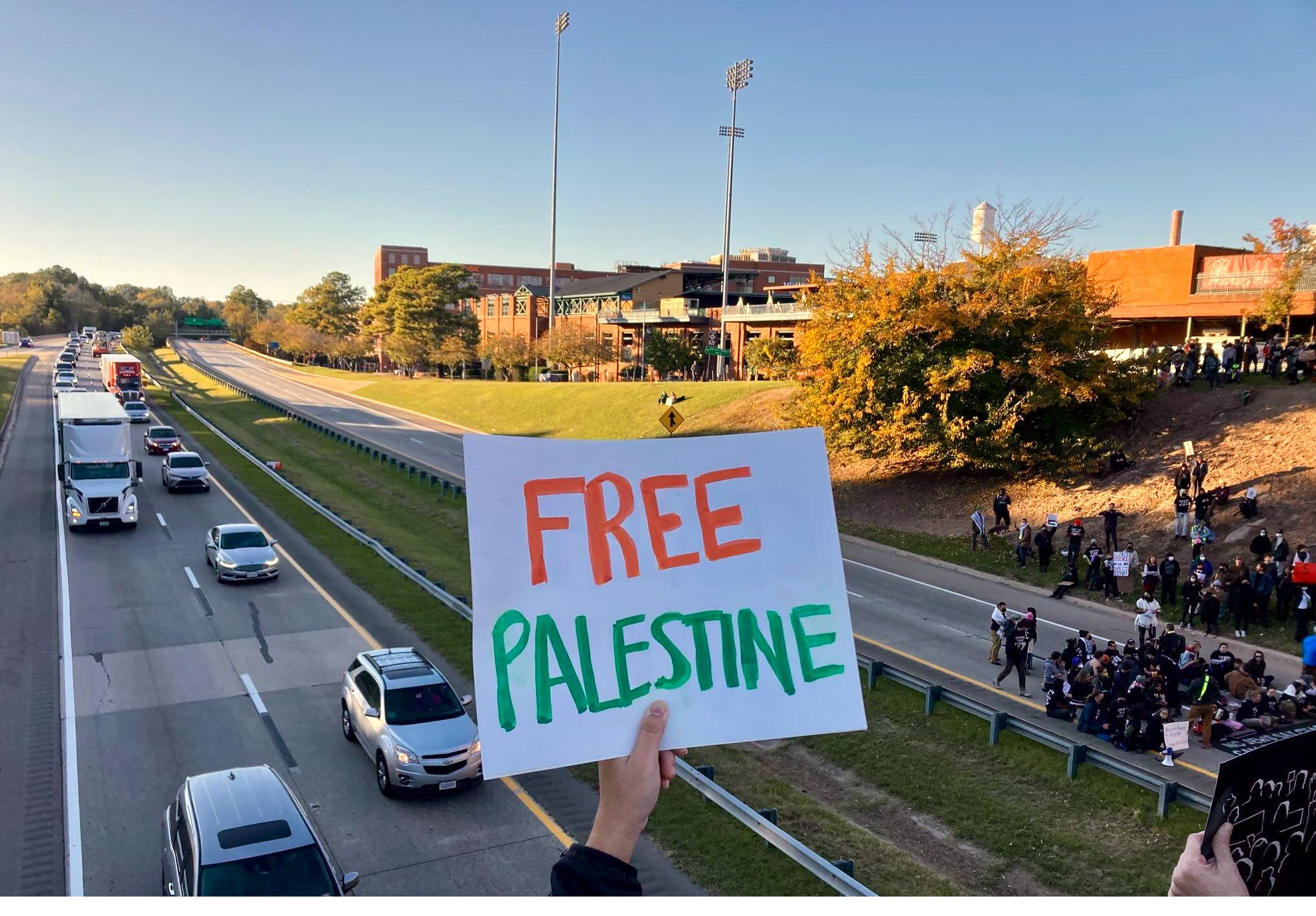
In Atlanta, Georgia, abolitionists and environmentalists have fought for three and a half years to stop the construction of a police militarization facility known as Cop City. The same police that are attempting to crush that movement have trained for decades with Israeli police, exchanging lethal counterinsurgency strategies. In the following text, a Jewish collective that has participated in the struggle to Stop Cop City explains why they are committed to solidarity with Palestinians and what it will take to halt the assault of the Israeli military on Gaza.
The Fayer Collective, a collective of Jewish anarchists, has participated in the fight against Cop City from the beginning as well as confronting fascists throughout the region.
For us, the fight against fascism isn’t about “allyship”; it is a personal and direct fight for our lives. And that knowledge has put a fire in our hearts, as both anarchists and Jews.
-Fayer Collective, Finding Our Own Fire
Now, they are attempting to stop the bloodbath in Gaza. In their own words,
Fayer is a collective of artists, revolutionaries, workers, students, criminals, and free lovers fighting for the earth, the good life, and total liberation. Members of the collective have been participating in the movement to Defend the Atlanta Forest since its inception, attending religious practices in the forest such as Shabbat dinners, Sukkot gatherings, purim parties, and other Jewish holidays, forging a spiritual bond between Atlanta’s radical Jewish community and the Weelaunee Forest it seeks to defend. With the renewed Zionist attacks on Gaza and the Palestinian people, which are supported by the Georgia International Law Enforcement Exchange Program based out of Atlanta, we have found ourselves in the unique situation of being near the inner workings of the machine and its local violence while simultaneously being far from its ruthless campaign for genocide. For this reason, we have decided it is imperative for us to lay out the situation from our perspective and what it means for the Atlanta Forest and Palestinian liberation.
Here, the Fayer Collective explores the protests calling for a ceasefire in Gaza, arguing that solidarity movements must shift from presenting demands to taking direct action and proposing some models for how to proceed.
The Ceasefire in Gaza Starts Here
In the weeks since Israel declared war on Palestine, people across the world have participated in protests against Israeli airstrikes in Gaza. Many of the largest protests have taken place in Europe and the United States, with 70,000 people taking to the streets in London last Saturday to demand an end to Israeli air strikes and the provision of arms to Israel. Protestors in Berlin (where pro-Palestine protests are now banned) clashed with police, who deployed pepper spray, water cannons, and physical force against protestors. Protests in support of Palestine have taken place in most major cities in the United States as well. In Chicago, 25,000 people assembled on October 21. For three weekends in a row, the Palestinian Youth Movement has called demonstrations in Atlanta that brought over 1000 people into the streets to demand an end to the Israeli occupation and the genocidal bombing of Gaza.
As of Thursday, November 2, the Israeli military had killed a reported 9193 Palestinians and wounded at least 32,000. At least half of the dead are civilian non-combatants, including at least 3,760 Palestinian children.
Grassroots support for Palestinians is at an all-time high despite Western politicians’ and war profiteers’ attempts to weaponize Jewish identity against them, outlaw and repress solidarity protests, and rally around Israel’s “right to defend itself.” But to stop the genocide in Gaza, activists in the United States will have to move from demanding a ceasefire to imposing one. This will require a shift from demands that appeal to the consciences of elected officials to tactics that create a political crisis for politicians and disrupt corporations’ ability to profit from the oppression and genocide of Palestinian people.
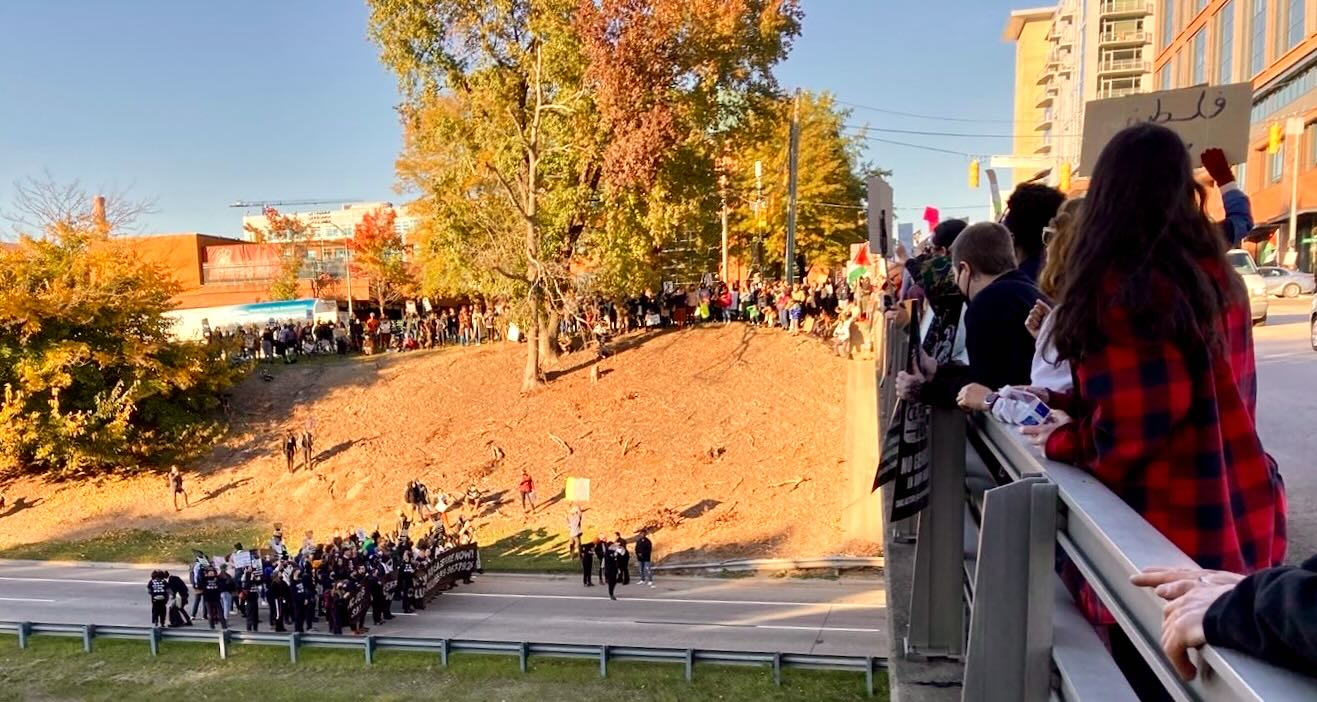
75 Years of War
As a result of the Nakba (“catastrophe”) of 1948, 78% of Palestinians’ historic homeland was declared a Jewish state. Approximately 500 Palestinian villages experienced ethnic cleansing and roughly 700,000 Palestinians became refugees. This is essential context for understanding subsequent events such as the Six Day War of 1967 and the 1973 Yom Kippur/Ramadan War, when a coalition of Arab states attempted to reclaim territory lost in the Six Day War.
On October 7, 2023, the fifty-year anniversary of the beginning of the Yom Kippur/Ramadan War, Hamas militants and other Palestinian groups breached the Gaza border by land, sea, and air in a surprise offensive.[4] These attacks left at least 1405 Israelis dead and 5431 injured, including an unknown number of children.[5] Hamas besieged several settlements in the territory around Gaza, taking 242 hostages. The Israeli government evacuated the area to regain control from Hamas, then carried out a larger evacuation to create a buffer zone in preparation to for the military invasion that is underway now.
So far, Hamas has released four Israeli civilian hostages. They have announced that they are prepared to release all the hostages in exchange for the return of all Palestinian prisoners held in Israeli jails, though they reported days ago that “almost 50” hostages had been killed by Israeli air raids.
Before October 7, there were 5200 Palestinian political prisoners in Israeli custody, more than 25 times the number of hostages Hamas has taken. Some estimates claim that the total number of Palestinian prisoners has doubled since October 7.
Israel’s airstrikes on Gaza have targeted civilian infrastructure including schools, aid agencies, mosques, and civilian housing units. There has been considerable controversy over whose missile hit the Al-Ahli hospital, but the tragedy illustrates how difficult it is to get information on the suffering taking place in Palestine and how readily Israeli officials will justify any kind of atrocity: shortly after the explosion at the hospital, an aid to Israeli Prime Minister Benjamin Netanyahu posted on social media that Israel had bombed the hospital because Hamas combatants were inside, then quickly deleted the post.
The Israeli Defense Forces (IDF) have long used military strategies targeting civilians and civilian infrastructure. In 2008, Israeli Defense Forces Colonel Gabi Siboni described Israel’s strategy of disproportionate force in the Second Lebanon War of 2006 as a policy of deploying “force that is disproportionate to the enemy’s actions and the threat it poses,” force that “aims at inflicting damage and meting out punishment to an extent that will demand long and expensive reconstruction processes.” Part of the Dahiya Doctrine of asymmetric warfare, the strategy of disproportionate force predominantly targets civilian infrastructure rather than enemy combatants, seeking to deter future offensive attacks by tying up the economy and civilian population in lengthy, costly reconstruction processes.
This scorched-earth approach to war can be seen in Israel’s air strikes in Gaza. These attacks on civilian infrastructure appear to represent an intentional strategy in which civilians and the resources they depend on become the primary targets of war. This suggests that the strategy of disproportionate force Israel developed in Lebanon is implicated in the devastating loss of life and life-giving infrastructure in Palestine.
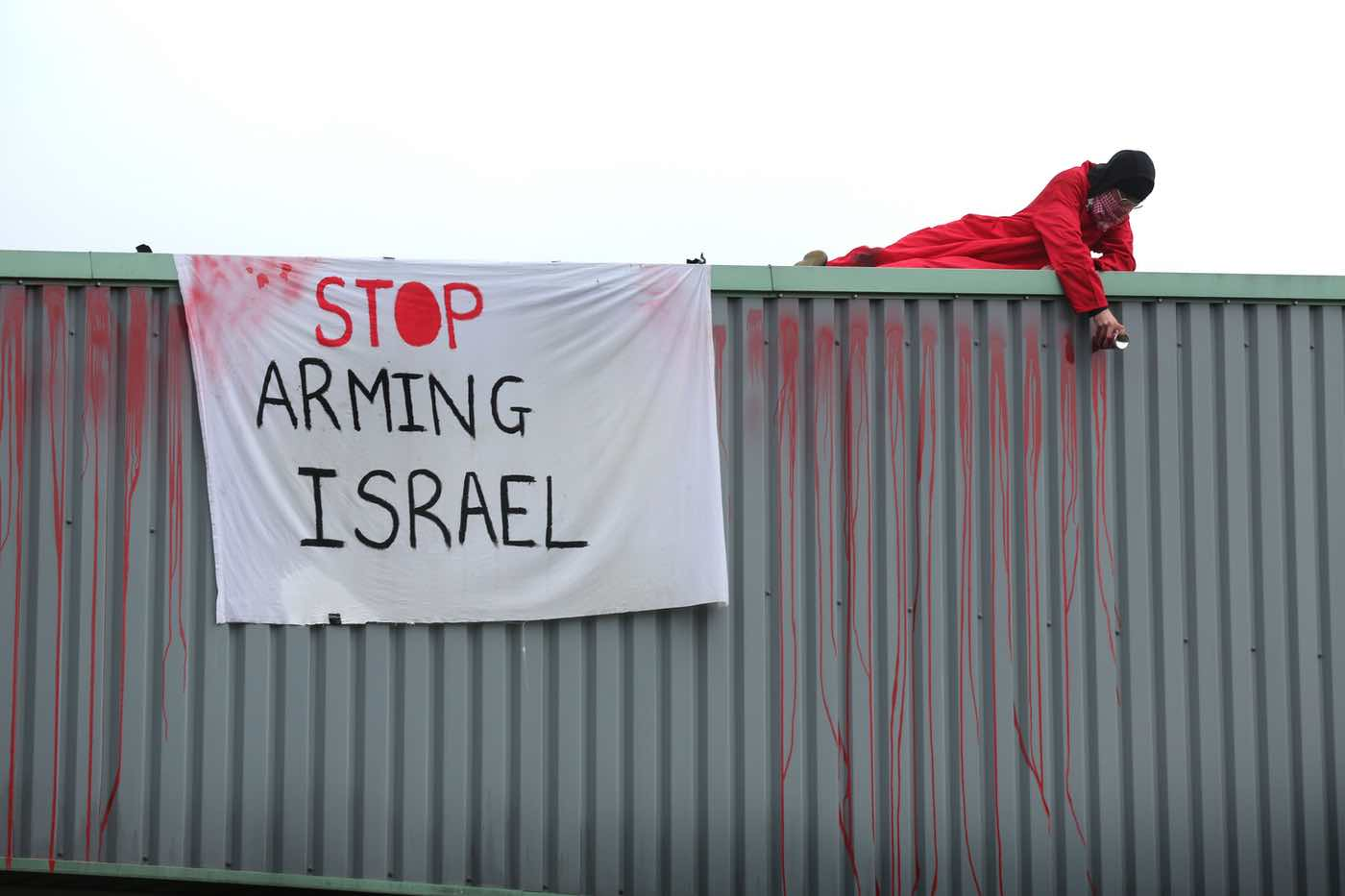
“Ceasefire now!”
Protests for Palestinian liberation have taken place in most major cities in the United States, often with thousands of participants. Many of these protests draw a through-line connecting the struggle for Palestinian liberation with the struggle against United States colonialism. Protesters have highlighted the fact that the United States government is the single largest donor to Israel’s military and most of the weapons used to kill Palestinians are manufactured by companies based in the United States.
In Atlanta, protesters have pointed to GILEE (Georgia International Law Enforcement Exchange) as a local link between Israel’s oppression of Palestinians and the police violence and repression facing Atlantans. Based out of Georgia State University, GILEE facilitates the international exchange of policing and repression tactics between Georgia police officers and Israeli police forces. Five Atlanta Police Department commanders were scheduled to visit Israel from October 13-21 as part of GILEE.
Activists in Atlanta are acutely aware of the global network of repression linking the Stop Cop City and Defend the Atlanta Forest movement to the movement for Palestinian liberation. Many have noted that Israeli forces will train at Cop City if it is built. On October 12, 300 Georgia State University students walked out of class to protest GILEE, understanding it as part of a system of “Deadly Exchange.” On October 25, Emory University students organized a walkout of over 100 students to demand that the Emory administration divest from Cop City, the Atlanta Committee for Progress, and the GILEE Program.
The ties between the Atlanta Police Department, Cop City, and Israel’s military forces have become a topic of public scrutiny in Atlanta because of the movement to Stop Cop City and Defend the Atlanta Forest. But GILEE is just one of dozens of such deadly exchange programs in the United States. Eight years before Minneapolis police murdered George Floyd, for example, officers in the Minneapolis Police Department received training from Israeli police forces at a conference in Chicago.
Jewish people living in the United States have also mobilized against the bombardment and invasion of Gaza, urging Biden to call for a ceasefire. The vast majority of these protesters reject Zionism (the movement born at the end of the 19th century to establish a Jewish state in the land of historic Palestine and to support that state by any means necessary) as a component of Jewish identity. Instead, many anti-Zionist Jews embrace the diasporic ethos that Jewish people have embodied for millennia.
One of the largest organizations in the United States calling for Palestinian liberation is Jewish Voice for Peace (JVP), a Palestine solidarity group founded in 1996. Jewish Voice for Peace sparked controversy in 2019 when the organization officially adopted an anti-Zionist position. On October 18, 2023, in Washington, D.C., Jewish Voice for Peace organized the largest known Jewish-led protest in solidarity with Palestinians. According to JVP, 10,000 people from across the country descended on the National Mall in a “Jews Against Genocide” rally. Nearly 500 Jews—including 25 rabbis—entered the Canon Building at the Capitol wearing shirts bearing the phrase “Not In Our Name” in bold letters. They held a sit-in for over three hours until they were arrested and dragged out in handcuffs.
Jewish Voice for Peace is not the only Jewish-led organization that has emerged in response to decades of violence against Palestinian people. In 2014, the Israeli military launched “Operation Protective Edge,” a military offensive in Gaza that killed more than 2200 Palestinians, over 65% of whom were civilians. In response to those attacks, a small group of Jewish youth who opposed the support American Jewish institutions for the invasion of Gaza founded IfNotNow, a Jewish youth organization based in the United States. The day before JVP demonstrated at the Capitol on October 18, members of IfNotNow blockaded all thirteen entrances of the White House while staff were inside and engaged in minor skirmishes with Secret Service police outside.
Though the number of Jews who have mobilized across the United States over the past four weeks is impressive, neither the demands they have presented nor the devastating civilian death toll in Palestine have swayed the decisions of elected officials.
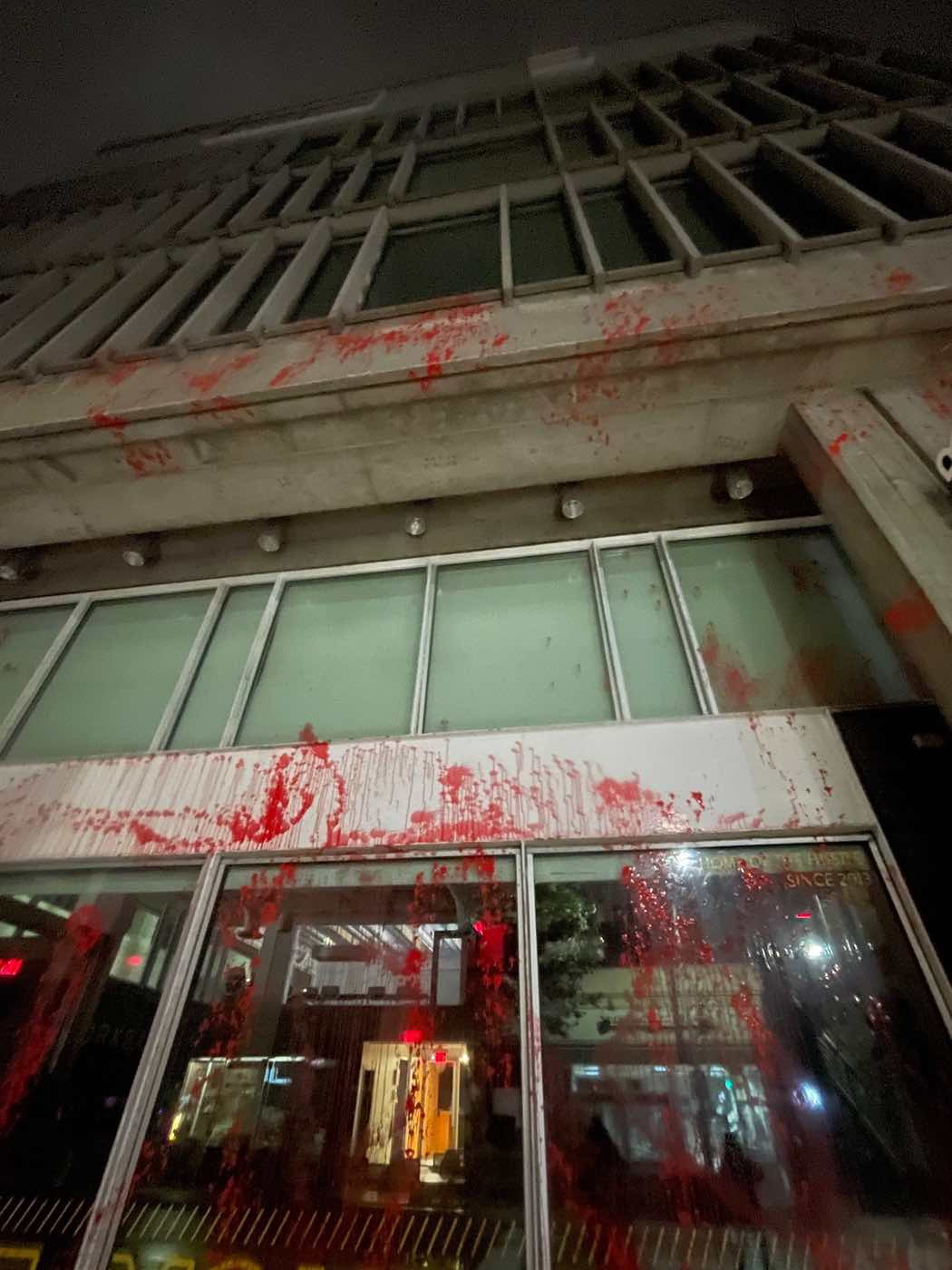
How to Start a Ceasefire
Recent demonstrations against the genocide in Palestine demonstrate nationwide popular support for Palestinian liberation among Jews and non-Jews alike. If these demonstrations have failed to end the attacks on Palestinians, it is because they are intended to appeal to the consciences of politicians whose support for Israel is based not on moral evaluations, but on economic calculations. Elsewhere, groups fighting for Palestinian liberation have begun to create an economic crisis for war profiteers by targeting the corporations that benefit from the bombing and invasion of Gaza.
Active in both the United Kingdom and the United States, a group called Palestine Action has targeted the weapons manufacturing company Elbit Systems, which supplies 85% of Israel’s drone fleet. On October 12, activists in Cambridge, Massachusetts splattered red paint on the front of an Elbit office before locking themselves together to blockade the entrance. Palestine Action recently announced its United States launch with a Zoom webinar on October 24 to explain their strategy, targets, and tactics. Early that same morning, activists targeted Intercontinental Real Estate, which owns the office building rented to Elbit in Cambridge. According to one report, they “smashed Intercontinental’s intercom box clear off the wall, covered the front wall of Intercontinental Real Estate’s Brighton office in red paint, and spray-painted ‘Evict Elbit’ in large black letters.”
According to reporting by Globes, Elbit’s stock prices have dropped by nearly 10% since October 7, while other weapons manufacturers have seen a 5-17% increase in the same period.
Earlier this year, Palestine Action forced a factory belonging to Elbit subsidiary UAV Defence Systems to permanently close after activists besieged it for 60 days straight. The group also forced Elbit to sell their Oldham-based subsidiary Ferranti in January 2022 after 18 months of sustained direct action at the factory. Six months later, the company permanently closed their London headquarters after the fifteenth direct action at the site.
In addition to targeting Elbit Systems and their subsidiaries, Palestine Action has also carried out a strategy of tertiary targeting, organizing actions at the offices and warehouses of companies with economic links to Elbit. Tertiary targeting puts pressure on a project’s core contractors by pressuring businesses that have less of a stake in the project to sever ties with them. Tertiary targeting was also utilized by the Stop Huntingdon Animal Cruelty (SHAC) campaign of the early 2000s and the Stop Reeves Young campaign of the Stop Cop City movement.
Movements in the United States have long used tactics such as blockades, home and office demonstrations, sit-ins, vandalism, and sabotage to take action against wars abroad. In the last month, targeted actions against war profiteers such as Elbit Systems and their subsidiaries show that popular anti-colonial sentiment can be channeled into effective action by striking at the economic heart of the processes that make war possible, rather than the consciences of elected officials. Thousands of miles away from the genocide in Palestine, everyday people in the United States may feel powerless to end Israel’s devastating attacks. But in fact, activists living in the colonial core have the power to directly disrupt the functioning of the institutions and war profiteers who benefit from genocide in Gaza.
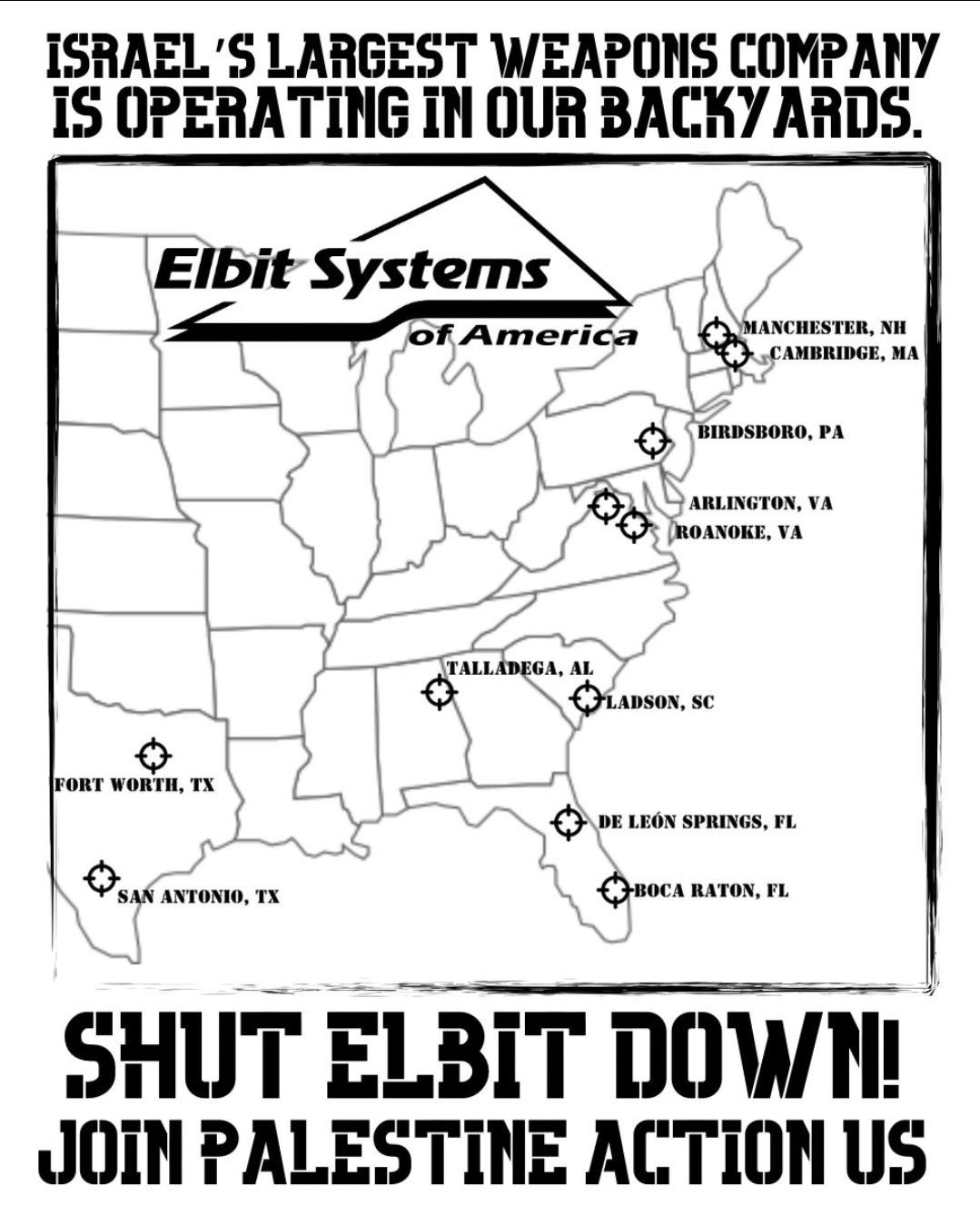
Publisher’s Afterword: The Uses and Limits of Tertiary Targeting
In the assessment of the SHAC campaign that we prepared with participants in that movement following a wave of repression that left many of the core organizers in both the United States and the United Kingdom serving prison terms, we argued that tertiary targeting strategies were more likely to succeed against smaller targets than Huntingdon Life Sciences, the animal testing corporation that the SHAC campaign set out to drive out of business. Before the SHAC campaign, an earlier movement using the same strategy had successfully shut down an individual fur store; but in attempting to close Huntingdon Life Sciences, which was then Europe’s largest animal testing corporation, activists picked a particularly high-profile target. Every time the campaign came close to shutting down HLS, government agencies stepped in to bail out the company.
Our conclusion was that
it would probably be wise for the next ones who experiment with the model to set smaller goals, rather than even more ambitious ones, since the SHAC campaign itself has yet to succeed. Perhaps some unexplored middle ground awaits between shutting down individual fur stores and attempting to close Europe’s largest animal testing corporation.
Despite this, most subsequent efforts to utilize the SHAC model have taken on larger adversaries, including transnational capitalist infrastructure projects and corporations working with the Atlanta city government to construct Cop City. When state infrastructure is at stake, government agencies will almost always intervene to protect corporations and other institutions from the consequences of tertiary targeting. To be capable of cutting off all resources to major players in the military-industrial complex, a movement would have to be powerful indeed.
This is not necessarily an argument against tertiary targeting. Rather, it is a reminder to set realistic expectations and formulate achievable goals. Even if it is not possible to run all the world’s weapons companies out of business one after another (at least—not without social change on an even larger scale), providing a horizon for more confrontational actions could offer additional leverage on the politicians and other decision-makers who are currently providing the Israeli military with carte blanche to carry out ethnic cleansing. Expanding the range of strategies that activists can participate in and the number of targets they can identify could open up new theaters of operation—giving new participants local points of intervention, escalating the intensity of ongoing protests, and increasing the pressure on those who hold the power to staunch the flows of weapons and blood.
[1] https://vimeo.com/881020815
[2] https://twitter.com/AbolitionistLC/status/1720186325624643720
[3] https://crimethinc.com/2014/12/12/feature-from-ferguson-to-oakland-17-days-of-riots-and-revolt-in-the-bay-area
[4] According to one source, the Israeli military estimates that at least “3000 militants” participated in the attack.
[5] Some reports suggest that some Israelis were killed by Israeli forces on October 7, whether as a consequence of “heavy crossfire” or of “shelling houses with all their occupants inside in order to eliminate the terrorists along with the hostages.”
[6] https://www.commondreams.org/news/protesters-target-israel-weapons-makers
[7] https://twitter.com/Pal_action/status/1713845456424301021
[8] https://twitter.com/Pal_ActionUS/status/1720234480793714993
